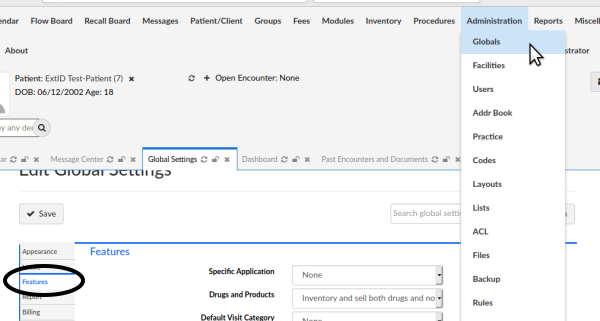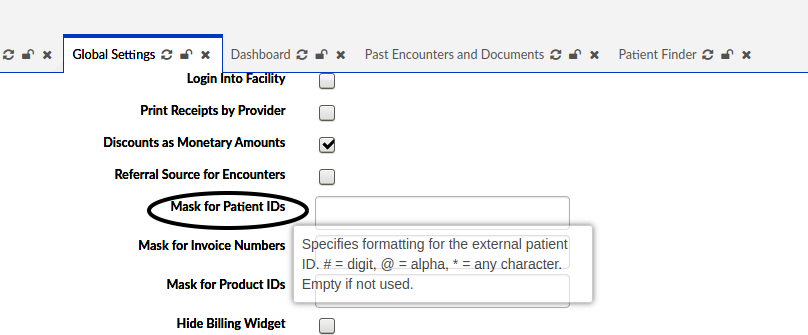Quickie External ID Mask Tutorial
From OpenEMR Project Wiki
Introduction
- OpenEMR permits the use of a configurable patient identifier called an 'External ID'.
- The format of the External ID can be controlled by a 'mask' which is a string of special characters that will enforce the use of only alphabetic or only numeric characters, or allow use of any characters.
- External IDs are useful if the practice requires that the ID has some specific datum in it such as the last 4 of the patient's SSN. Or if they want to use the same ID as some outside facility such as a hospital that providers have admitting privileges to.
Procedure
1. Set the mask in Features tab
- From the Main Menu, 'Administration/ Globals', the 'Features' tab (oval below)...
in the text area labeled 'Mask for Patient IDs' (oval below)
- The formatting of the External ID can be set as # = digit, @ = alpha, * = any character.
- *NOTE: do not include spaces in the mask, they will confuse the filter mechanism
- In this example I set the mask as:
- @@@-###-****
- which requires 3 alpha + hyphen + 3 numeric + hyphen + 4 any characters
2. Create the new patient
- From Main Menu go to: Patient/Client -> 'New/ Search'
3. Manually enter the External ID in the desired format.
- Using this sample mask, as soon as the 3 alphabetic characters were entered, a hyphen was automatically appended. After the 3 numeric characters a hyphen appeared; adding the last alphanumeric characters allowed the new patient to be saved.
Conclusion
OpenEMR's External ID functionality provides the ability to make the patient record's identifier more easily read by human readers.
Good things to know:
- Once a mask is specified, the external ID must be entered for all subsequent new patients.
- If the mask is deleted from the Globals' Features, any subsequent new patients can be automatically assigned the system PID by the default mechanism, or given any arbitrary Ext ID that doesn't need to conform to any pattern.
- In this demo all the patients above the one we just created (rectangle in pic below) were made without an Ext ID mask. So they either received the PID in the order of their creation, or that AA123 which is an arbitrary Ext ID that was entered without a mask.
- And for the one after it, (ID#7) the Ext ID mask from above had been deleted and the ID assignment reverted to automatically providing the PID.
- Even if an External ID is used for human- facing displays of the patient's EMR record, the system PID is always retained as the EMR's internal patient identifier.




